Please report any broken links or trouble you might come across to the Webmaster.
Please take a moment to let us know so that we can correct any problems and make your visit as enjoyable and as informative as possible.
| Click On Image For Full Size | Size | Image Description | Source | |
|---|---|---|---|---|
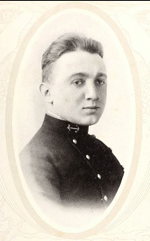 0804900 | 31k | Sponsor: Miss Heather Pattison Baxter, daughter of Naval Constructor W. J. Baxter, U. S. Navy, Chief Constructor at Navy Yard, Boston, Massachusetts. She was camera shy, but a photo of her husband, Comndr. Myron Wells Hutchinson Jr., exists here. | Image and text provided by findagrave.com | |
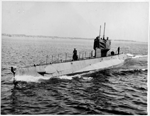 |
1.22k | L-9 (SS-49) underway, probably while running trials in 1916. | USNHC photograph # NH 63383. | |
 |
743k | All the news that's fit to misprint, #1. UNITED STATES TESTS FIRST OF BIG NEW SEA-GOING SUBMARINES The M-1 (SS-47) is shown on her trial trip off Provincetown, Mass., on 6 July. She is 230 1/2 feet long, with 21 1/2-foot beam. Her radius of action is 2,000 miles. She is not as large as the German submarine Deutschland, now at Baltimore, whose length is 315 feet, with a 30 foot beam. It is actually an EB design L-class boat. The paper that originally published the photo misidentified it. The caption is wrong. | Photo & text i.d. courtesy of David Johnston Image provided by: Penn State University Libraries; University Park, PA. Photo from Evening Public Ledger. (Philadelphia [Pa.]) 1914-1942, 11 July 1916, Night Extra, Image 2, via chroniclingamerica.loc.gov. | |
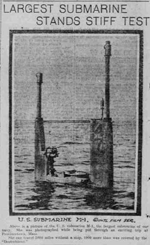 |
531k | All the news that's fit to misprint, # 2. LARGEST SUBMARINE STANDS STIFF TEST Above is a picture of the U.S. submarine M-1 (SS-47) the largest submarine of our navy. She was photographed while being put through an exciting trip at Provincetown. Mass. She can travel 5000 miles without a stop, 1000 more than was covered by the Deutschland.". It is actually an EB design L-class boat. The paper that originally published the photo misidentified it. The caption is wrong. | Photo & text i.d. courtesy of David Johnston Image and text provided by University of North Texas; Denton, TX. Photo from El Paso Herald. (El Paso, Tex.) 1901-1931, 21 July 1916, HOME EDITION, Image 6, via chroniclingamerica.loc.gov. | |
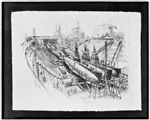 |
127k | What looks to be L-class (SS-40/51) submarines in dry dock, by the artist Joseph Pennell, 1917. | Photo # 3c19552v, LC-USZ62-119552. Photograph courtesy of memory.loc.gov. | |
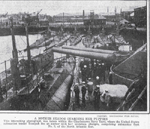 |
496k | A MOTHER SEADOG GUARDING HER PUPPIES This interesting photograph was taken within the Charlestown Navy Yard, where the United States submarine tender Tonopah (M-8) lies at anchor with her undersea charges, comprising submarine fleet No.3, of the North Atlantic fleet. Probable submarines are the E.B. designed L-boats (SS-40 / 43 & 49 / 51), [L-1 thru 4 & 9 thru 11.] | Image and text provided by Penn State University Libraries; University Park, PA. Photo from Evening Public Ledger.(Philadelphia [Pa.]) 1914-1942, 02 June 1917, Postscript Edition, Pictorial Section, Image 19, via chroniclingamerica.loc.gov. |
|
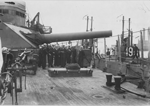 |
1.28k | The photo above shows the same scene here but from a different angle. View on the Tonopah's (M-8) foredeck, showing 12" guns and crewmen, taken while she was serving as submarine tender at the Boston Navy Yard, Charlestown, Massachusetts, circa June 1917. Submarines alongside are L-11 (SS-51) and L-9 (SS-49). Note the workbench, with vise attached, in the left foreground. |
Photo i.d. via Ric Hedman. National Archives Identifier: 45513433 Local Identifier: 165-WW-337D-63 Photo courtesy of catalog.archives.gov |
|
 |
100k | Circa December 1917 - January 1918 photo of the L-9 (SS-49), L-10 (SS-50) & L-11 (SS-51) wearing the A.L. of WW I, at Portsmouth, New Hampshire. | USN photo courtesy of Robert M. Cieri. | |
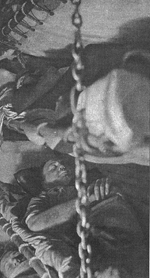 |
753k | Sack Time. Typical of the subject submarines, here men are stacked four high on canvas fold away bunks aboard an American L-boat in the European theater. | Photo from Illustrated London News, 28 September, 1918, courtesy of Beneath the Surface: World War I Submarines Built in Seattle and Vancouver by Bill Lightfoot. | |
 |
85k | Prewar U.S. submarine bridges were very small to limit underwater drag. With her enlarged chariot bridge, L-3 (SS-42) contrasts with the more streamlined L-9 (SS-49) in this 1918 photo(which was less suited to protracted surface runs). | Photo & text courtesy of U.S. Submarines Through 1945, An Illustrated Design History by Norman Friedman. Naval Institute Press. | |
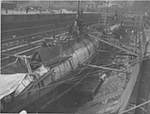 | 403k | US Submarines in Dry Dock at Charlestown Navy Yard. The L-11 (SS-51) & L-9 (SS-49). | Photographer: Kadel & Herbert, NY. National Archives Identifier: 45548689 Local Identifier: 165-WW-505C-1. Photo courtesy of catalog.archives.gov | |
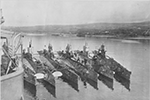 | 1.02k | L-boats alongside Bushnell (AS-2) at Bantry Bay, Ireland, in 1918.
These submarines are, from left to right: L-11 (SS-51), L-10 (SS-50), L-1 (SS-40), L-9 (SS-49) & L-2 (SS-41). Identification marks painted on these "boats"' fairwaters include the letter "A", to distinguish them from British L-boats . | National Archives Identifier: 45513695 Local Identifier: 165-WW-338B-003 Photo courtesy of catalog.archives.gov | |
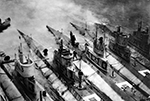 |
600k | "L" class submarines probably alongside Bushnell (AS-2) at Bantry Bay, Ireland, in 1918. L-3 (SS-42), L-1 (SS-40), L-10 (SS-50), L-4 (SS-43), L-9 (SS-49). | USN photo # Lot-5410-23,Secretary of the Navy Josephus Daniels Collection. Photographed through Mylar sleeve. Courtesy of the Library of Congress via National Museum of the U.S. Navy via flickr.com. | |
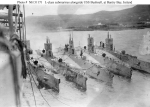 | 80k | L-boats
alongside Bushnell (AS-2) at Bantry Bay, Ireland, in 1918.
These submarines are, from left to right: L-1 (SS-40), L-10 (SS-50), L-4 (SS-43)& L-9 (SS-49). | USNHC photograph # NH 51171. | |
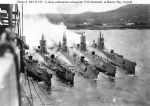 | 87k | L-boats alongside Bushnell (AS-2) at Bantry Bay, Ireland, in 1918.
These submarines are, from left to right: L-1 (SS-40), L-10 (SS-50), L-4 (SS-43)& L-9 (SS-49). Note the smoke from the submarines' engines. | USNHC photograph # NH 51170. | |
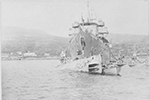 | 221k | Bushnell (AS-2) lifting L-2 (SS-41) partially out of the water, while in an Irish port during World War I.
Moored to Bushnell's
port side are (from left to right): L-4 (SS-43), L-1 (SS-40), & L-9 (SS-49). | National Archives Identifier: 45513749 Local Identifier: 165-WW-338B-28 Photo courtesy of catalog.archives.gov | |
 |
133k | L-9 (SS-49), during World War I at Bantry Bay, Ireland. The prefix "A" denoted "American" as the British also had L-Boats in the area. L-9 shows typical war modifications: a chariot bridge and retractable (housing) periscopes. |
Partial text courtesy of U.S. Submarines Through 1945, An Illustrated Design History by Norman Friedman. Naval Institute Press. US National Archives photo 80-G-1025041, a USN photo now in the collections of the US National Archives, contributed by Joseph M. Radigan (of blessed memory) |
|
 |
583k | AMERICAN SUBMARINES return to the base to "feed." A School of U.S. subs alongside their mother ship at an advance base on the Irish coast. L-9 (SS-49) is the second submarine on the right, what might be L-11 (SS-51) is the second submarine on the left. | Image and text provided by Penn State University Libraries; University Park, PA. Photo & text by Evening Public Ledger. (Philadelphia [Pa.]) 1914-1942, 23 January 1919, Night Extra Closing Stock Prices, Image 20, courtesy of chroniclingamerica.loc.gov. |
|
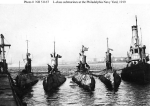 | 89k | L-class class submarines tied up at the Philadelphia Navy Yard, Pennsylvania, with a harbor tug outboard, circa February 1919.
Submarines are (from left to right): L-3 (SS-42); L-9 (SS-49); L-11 (SS-51); and L-2 (SS-41). | USNHC photograph # NH 51167. | |
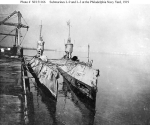 |
100k | View of the L-9 (SS-49), at right and L-3 (SS-42) at the Philadelphia Navy Yard, Pennsylvania, circa February 1919. | USNHC photograph # NH 51166. | |
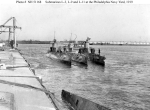 |
100k | L-3 (SS-42) - left; L-9 (SS-49) - center; and L-11 (SS-51) - right, at the Philadelphia Navy Yard, Pennsylvania, circa February 1919. "Homeward-bound" pennant flying from L-9's periscope indicates that this photo may have been taken as the submarines arrived home following World War I service in British waters. | US Naval Historical Center photo # NH 51168. | |
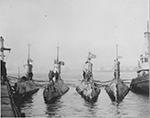 |
873k | AMERICAN U-BOATS BACK FROM THE WAR After 15 months hunting of German U-boats in the Irish Sea, the flotilla of submarines shown above returned to the League Island navy yard at Philadelphia. The L-11 (SS-51), (third from left) had many desperate encounters with the enemy boats, including a fight below the surface with a Hun sub, which L-11 subsequently vanquished. L-9 (SS-49) is the second boat to the left, along with two unidentified submarines, which I believe are L-2 (SS-41) at the far right & L-3 (SS-42) on the left. |
National Archives Identifier: 45513697 Local Identifier: 165-WW-338B-3A Photo courtesy of catalog.archives.gov Image and text provided by University of Oregon Libraries; Eugene, OR. Photo courtesy of The Evening Herald. The Evening Herald. (Klamath Falls, Or.) 1906-1942, 24 April 1919, Image 3, via chroniclingamerica.loc.gov. | |
 |
513k | AMERICAN SUBMARINES BACK FROM WAR ZONE Four of America's Latest type submersibles which have seen 24 months of active service in the war zone have returned and are here shown anchored in the navy yard at Norfolk, Va. L-9 (SS-49) is the first submarine on the left. | Image and text provided by University of Nebraska-Lincoln Libraries, Lincoln, NE. Photo & text by The North Platte Semi-Weekly Tribune. (North Platte, Neb.) 1895-1922, 29 August 1919, Image 6, courtesy of chroniclingamerica.loc.gov. | |
 0807700 | 674k | Philadelphia in the late 1920ís. From left to right: Two K-class: (No definite i.d. which ones of the following 8 ): K-1 (SS-32), K-2 (SS-33), K-3 (SS-34), K-4 (SS-35), K-5 (SS-36), K-6 (SS-37), K-7 (SS-38), K-8 (SS-39). Four EB design L-class (No definite i.d. which ones of the following 4 ): L-2 (SS-41), L-3 (SS-42), L-9 (SS-49) & L-11 (SS-51). Two Lake design O-class (No definite i.d. which ones of the first 4): O-11 (SS-72), O-13 (SS-74), O-14 (SS-75), O-15 (SS-76 ), with the last boat being O-16 (SS-77) on far right. All boats are in various states of disrepair, and all would be disposed of by scrapping by the summer of 1930 in accordance with the London Naval Treaty. | Photo courtesy of David Wright. Text i.d. via David Johnston. |
|
| Back To The Main Photo Index | Back To the Submarine Index |
|
Problems and site related matters, E-mail Webmaster |
|
This page is created and maintained by Michael Mohl All Pages © 1996 - 2024 NavSource History |